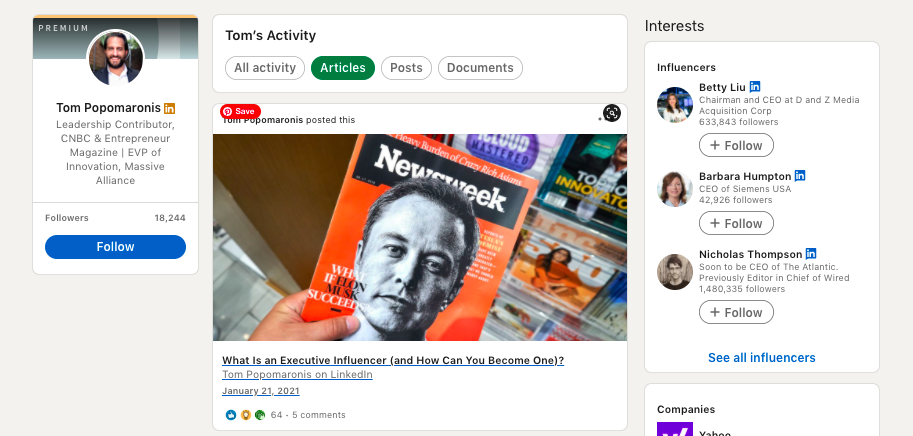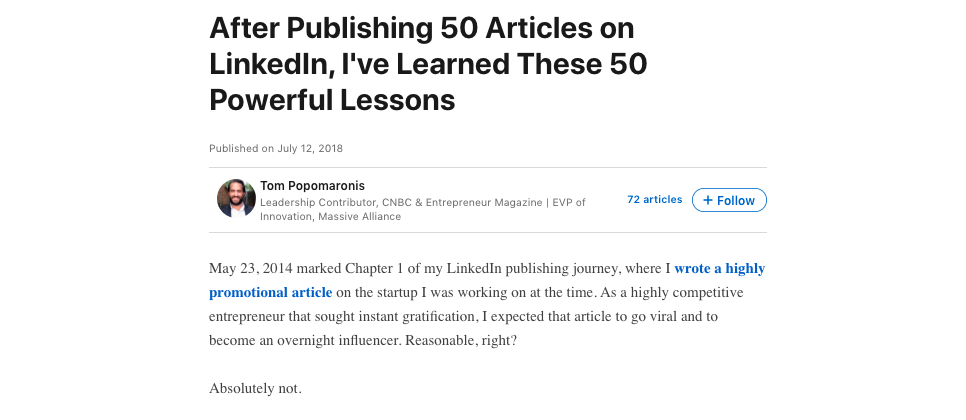Resources
Is Publishing on LinkedIn Worth Your Time?
By Jackson Knapp February 4th, 2021You may know LinkedIn as the place where out-of-touch relatives endorse you for Microsoft Word skills. You may consider it “Facebook with khakis” and use it only to congratulate old buddies on work anniversaries. If you’re lucky, maybe it’s helped you land a dream gig. But for freelancers, the platform has another trick up its sleeve—publishing on LinkedIn can help you build your brand and maybe even land paying work.
Separate from a LinkedIn post, which is a buttoned-up, corporate version of a social media update, LinkedIn publishing lets users share their own longform content of up to 110,000 characters. It’s easy to use, gives writers autonomy, and offers a chance to tap an audience of existing connections.
However, while a LinkedIn byline can be a helpful tool for getting your name out there, expect to play the long game to reap the platform’s full rewards. Tom Popomaronis, a freelance business writer and CNBC contributor, has been tinkering with his LinkedIn publishing formula since 2014. “[Writing articles on LinkedIn] shows that you’re committed to sharing insights with your network of peers and colleagues, whether you have 10,000 connections or 100,” he said. “It’s also a great portfolio builder.”
Why to Consider Publishing on LinkedIn
Time-pressed freelance creatives may wonder about the point of publishing on LinkedIn when they already juggle a personal blog, website, portfolio, and paying clients.
There’s arguably a faster payday associated with platforms like Medium, which give self-publishers the opportunity to earn money through its partner program. Medium’s buzziest posts also get curated and distributed to readers across its platform in ways that LinkedIn articles don’t. Personal blogs give writers much more control over how their content looks, as well as an opportunity to build a following via their own website, which can help with SEO.
But there’s still merit to LinkedIn’s professional cache. LinkedIn has 740 million members and 90 million senior-level influencers. Your network isn’t just made up of who you know, but also second- and third-degree connections. So if you self-publish, you’re speaking to a bigger audience than just college friends and ex-bosses. If any of your contacts share or “like” your article, looser connections may also see it, which gives you more exposure.
It’s also worth noting that LinkedIn is slowly rolling out the ability for all users to create newsletters right on the platform. The feature lets authors develop subscribers, who receive push, in-app, or email notifications every time you publish something new. For those who plan to write articles for LinkedIn regularly, this option—currently available on an invite-only basis—is one way to cultivate a dedicated readership.
Popomaronis also likes that LinkedIn lets you customize which articles to highlight. While every article is archived under your “activity” tab, you can feature your favorites so they’re the first thing someone sees when they click on your profile—sort of like a pinned Tweet. What’s more, you have total control over who can see your work. Public articles on public profiles cast the widest net, but you can tailor permissions to your LinkedIn updates by selecting a subset of your connections in your settings.
Keep in mind that publishing on LinkedIn isn’t exclusive. John Espirian, a copywriter who’s written extensively about the professional network, pointed out that you can always republish the same piece on multiple platforms. Just be sure to tweak the headline—and double-check that the content is a fit for LinkedIn’s professional nature. A 5,000-word thinkpiece about celebrity gossip may fit on your Medium account, but it probably doesn’t belong on LinkedIn.
The Pain Point
LinkedIn ultimately wants users to stay on its site—so it’s not an ideal tool for driving readers to another location. There’s also not much flexibility with aesthetics or branding, and the articles themselves look a little plain.
And while LinkedIn articles can help expand your network and establish you as a subject matter expert, don’t expect them to break the internet. “In my opinion, ‘going viral’ on LinkedIn doesn’t exist anymore,” Popomaronis said. The number of potential views on your content is massive, but LinkedIn employs a complicated algorithm, so not every connection sees every post in their feed.
To this point, you’ll get more traction if your posts cover appropriate topics for your network. “Crafting relevant content is so much more important than the quest for virality,” Popomaronis said. “It’s just a long-tail play.” Not all writers are willing to take on such a time commitment.
Finally, articles can be tricky to find if you’re browsing someone’s profile. It can be tough to distinguish articles from run-of-the-mill posts.
Best Practices for Success
It’s helpful to think of LinkedIn as an extension of your resume. Whether publishing an article or listing your skill set, the whole point of your profile is to get work. If there’s a nagging question that keeps popping up in your professional circles, a LinkedIn article could be the perfect place to answer it—and position yourself as a resource or expert.
Even one well-conceived piece can go a long way toward this goal. “Once you publish an article, you’re solidifying your foundation as a thought leader on the specific topic,” he said. But don’t get too cocky—it takes commitment and consistency to build momentum. Popomaronis suggested sharing every article with your network as a social media post that includes a call to action and three to five relevant hashtags.
LinkedIn also shares analytics of every article for two months after you publish. Writers get breakdowns of pageviews, along with data on where your readers work, job titles they hold, and where they live—all helpful in understanding your audience and refining your messaging.
The LinkedIn algorithm also gives some good hints about the kind of content you should consider writing. Its personalized discover hub recommends pages, companies, and profiles to connect with based on your skill set, along with hashtags to use when sharing articles to boost engagement. You should also check out LinkedIn’s publishing guidelines and tips for boosting distribution. Note that while publishing on LinkedIn can be great for thought leadership, it’s not meant for overt advertising—the platform has separate products for that.
Part of success with LinkedIn publishing comes down to understanding its benefits and limitations. “If you’re expecting overnight fame and inbound leads, you should reset your expectations,” Popomaronis said.

